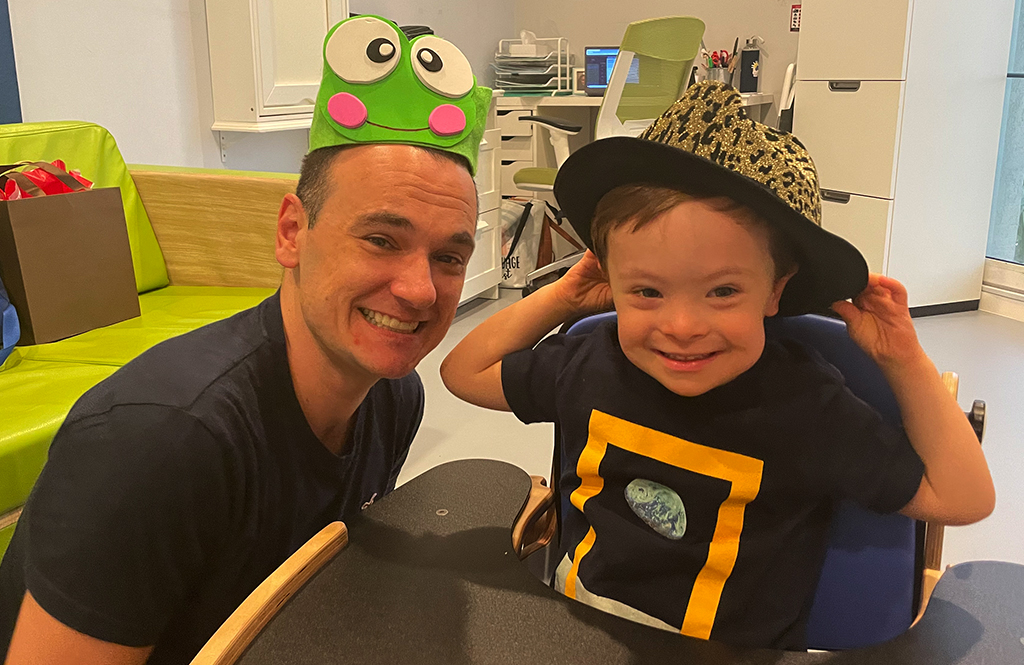
Research proves that following daily routines such as bathing, feeding, changing clothes, and riding in a car significantly impacts children’s communication and language development, thus benefitting children with language delays. “The home and community environments of young children are now recognized as important sources of learning opportunities for acquiring literacy and language abilities” (Huebner, 2000; Stainthorp & Hughes, 2000; Wood, 2002).
It is during daily routines that the highest parent-child interactions happen, which are ripe with pleasurable learning opportunities. These routines also expose children to both non-verbal communication—such as gestures, giggles, facial expressions, and voice intonation—and language, including sounds, words, and sentences.
A study entitled Parenting Behavior and Child Language: A Meta-analysis (Madigan et al., 2019) offers further evidence that parents who engage in daily routines with their children provide them with repetitive learning opportunities in a natural and enjoyable environment, hence improving language outcomes.
As a speech and language therapist with 10 years of experience involving parents in their children’s intervention, I have learnt that parents, if provided with the right guidance, can be as effective as—if not more effective than—therapists in offering intervention to their children with language delays.
Children’s language skills improve when parents use naturalistic teaching strategies by incorporating daily activities and routines into a child’s life, following the child’s lead, and consistently responding to their attempts at communicating during these activities. For example, talking to your child while changing their clothes or offering them a snack while they are playing with their toys are daily routines that could be used to teach your child new words or sentences.
Parents can leverage multiple day-to-day activities to teach language to their children, including:
- Mealtime
- Bedtime
- Bath time
- Going for a walk
- Tidying up
- Baking and/or cooking
- Playtime, both 1:1 and with siblings
- Gardening
- Grocery shopping trips
- Commuting time
To maintain clear, two-way interactions with your child during the above-mentioned activities, try to communicate with them face-to-face as much as possible. Then, observe what your child is interested in during these activities. Wait and give your child time to initiate an action or a comment by silently and slowly counting to 10. Lastly, listen to what they are saying so you can respond, let your child feel that you are fully present and that what they say is important to you, and show them that you are trying your best to understand them.
Another powerful tool to promote language skills during daily routines is to follow your child’s lead with your actions and words: imitate your child’s actions, sounds and words; interpret what your child is trying to say; and make a comment that is aligned with what your child is doing or saying.
Moreover, to keep the interactions going between you and your child, try to take turns. This will teach your child to pause and listen, which will help them learn new vocabulary and develop their receptive language skills. You may take turns while singing nursery rhymes during a car ride, pausing in the middle of the song to invite your child to fill the missing word.
It is also important to ask questions that keep the conversation going, including choice questions (e.g.: do you want to wear the yellow shirt or the green shirt?), yes-or-no questions (e.g.: do you want to play with the blocks?), and wh-questions (e.g.: where is your ball? Who is here?). Finally, avoid conversation stoppers, including asking too many questions or asking questions that your child does not have time to answer, test your child’s knowledge, are too hard for your child to answer, are not related to your child’s interests, and questions that answer themselves.
Here is an example of how you can turn a simple daily routine, mealtime, into a situation full of learning opportunities:
- Offer food options: “Would you like an apple or an orange?” You can show both fruits to your child and wait for a verbal or non-verbal response.
- Provide a small amount then wait: Provide your child with a small amount of food to encourage them to ask for more. You may cue your child by asking, for example, “more rice?” or “do you want more cookies?”
- Act silly: Give your child yogurt without a spoon or cake without a fork to encourage them to request the cutlery. You can cue your child to use one word such as “fork” or a simple phrase “I want fork”.
- Describe the food: Comment on its color (red, yellow, green), texture (sticky, soft, hard), taste (sweet, savory, sour, spicy), size (small/big), temperature (hot/cold), etc.
- Prepare the food together: Label the ingredients, narrate the cooking steps using verbs and sentences, count and measure ingredients using quantitative concepts (more, less, half, quarter, etc.), and talk about preferences using mental state words such as “I like”, “I prefer”, and “I think”.
High Hopes offers a family-centered speech therapy approach that involves and empowers a child’s parents. We encourage parents to not only watch therapy sessions, but also take part in them. Our therapists encourage parents to become active members of their child’s intervention team by providing them with practical tools and strategies to apply at home.
Contact us today to learn how we can help you identify your child’s stage of communication and select the most appropriate interaction strategies for them.
Sources:
- Carl J. Dunst, Andrea Valentine, Melinda Raab, Deborah W. Hamby. Relationship Between Child Participation in Everyday Activities and Early Literacy and Language Development. CELLreviews, 2013, Volume 6, Number 1.
- Madigan S, Prime H, Graham SA, et al. Parenting Behavior and Child Language: A Meta-analysis. Pediatrics. 2019;144(4):e20183556
- Roberts, M., & Kaiser, A. (2011). The Effectiveness of Parent-Implemented Language Intervention: A Meta-Analysis. American Journal of Speech-Language Pathology, 20, 180–199.
- Rakap, S. & Rakap, S. (2014). Parent-implemented naturalistic language interventions for young children with disabilities: A systematic review of single-subject experimental designs. Educational Research Review, 13, 35-51.
- Heidi M. Feldman, MD, PhD (2019). The Importance of Language-Learning Environments to Child Language Outcomes. Pediatrics (2019), Volume 144, Issue 4.
- Jan Pepper and Elaine Weitzman. It Takes Two to Talk: A Practical Guide For Parents of Children With Language Delays. A Hanen Center Publication. Fourth Edition, 2004.





